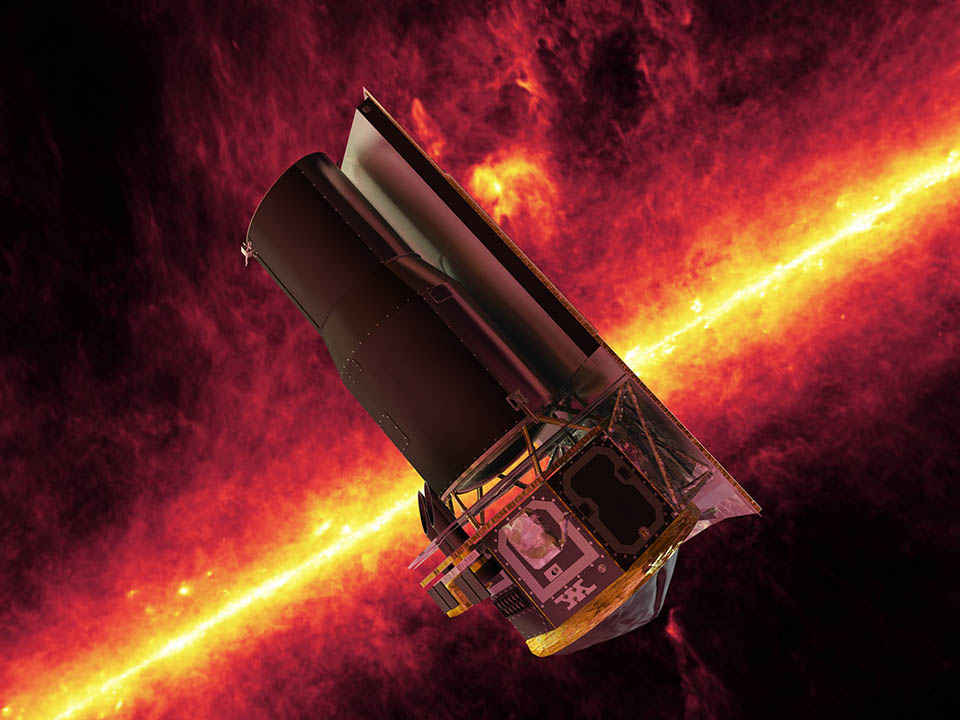Products You May Like
WASHINGTON — NASA will turn off an aging infrared space telescope in a week, citing the complexities of continuing to operate the spacecraft as it drifts away from the Earth.
On Jan. 29, the Spitzer Space Telescope will transmit the last of the science data that the spacecraft has collected. Controllers will then effectively turn off the spacecraft, ending a mission that started with its launch in 2003.
“On the 30th, we’re going to put Spitzer into a hibernation mode,” said Joseph Hunt, project manager for the Spitzer Space Telescope, during a NASA Television event about the end of the mission Jan. 22. Spitzer, he said, will be put into a “sun-coning attitude” where it will remain permanently.
He added there is no need to “passivate” the spacecraft like Earth-orbiting spacecraft at their end of their missions, which usually involves discharging batteries and venting propellants to eliminate any energy sources that could cause an explosion that would create debris that, in Earth orbit, would be a hazard. “There’s nothing out there for Spitzer to crash into,” he said.
Spitzer launched in August 2003 into an orbit around the sun that causes the spacecraft to gradually drift away from the Earth. NASA selected that orbit to minimize the infrared radiation from the Earth that would make it difficult for the spacecraft to perform its observations.
Over time, though, the spacecraft has drifted far enough from the Earth — it is now more than 250 million kilometers away — that it has becoming increasingly difficult to operate the spacecraft effectively.
“The angle between the Earth, sun and Spitzer makes it so that it’s very difficult to point the solar panels at the sun, to point the antenna at the Earth, to point the telescope where you want it look and to keep the sun from shining in the wrong places and warming the telescope up,” said Paul Hertz, director of NASA’s astrophysics division, during a Jan. 23 meeting of the Astronomy and Astrophysics Advisory Committee.
“There’s not a hard cutoff as to when it’s not possible to operate Spitzer,” he added, noting that the telescope was still working well. “But it is becoming increasingly more difficult to operate and more risky to operate.”
NASA originally planned to shut down Spitzer by early 2019, a decision made when the James Webb Space Telescope was set to launch in the fall of 2018 and thus allow for a transition. When NASA delayed the launch of JWST to 2021, the agency decided to extend Spitzer, but only to 2020, citing the growing complications of operating the spacecraft. “Some time in the near future, it would have become impossible to operate Spitzer, so we have a planned end to the mission,” Hertz said.
The agency, though, did entertain options to extend the mission further using outside funding. In 2017, NASA officials released a request for information seeking interest in taking over Spitzer operations after an end-of-mission then planned for March 2019. NASA later said it received two proposals from organizations who were interested, but who ultimately were not able to come up with the funding needed to operate it. Spitzer cost NASA $11.2 million in fiscal year 2018.
NASA announced in May 2019 that it would end Spitzer Jan. 30, announcing then a “Final Voyage” phase of the mission. The overall cost of Spitzer, from its initiation to closeout, to NASA is $1.3 billion, Hertz said at the Jan. 22 NASA TV event.
Spitzer lasted far longer than planned. When the spacecraft launched, it had a prime mission of only two and a half years. The spacecraft exhausted its supply of helium coolant in 2009, ending some infrared observations, but it was able to continue work at some shorter infrared wavelengths.
The end of Spitzer leaves NASA without a space-based infrared telescope at least until the launch of JWST, followed by the Wide-Field Infrared Survey Telescope in the mid-2020s. However, Hertz said on NASA TV he was not worried about any gap in infrared observations. “We’re well-positioned to continue studying the universe in infrared, and the gap of a year or so really is not a concern.”
While Spitzer will be placed into hibernation, Hunt said it would be effectively impossible to turn it back on at some point. Part of that is because of the spacecraft’s increasing distance from the Earth, he said, but another reason is that a customized ground system for operating Spitzer will be disassembled after Jan. 30. “Once that system is dissolved, it makes it very difficult or impossible to resurrect,” he said.
